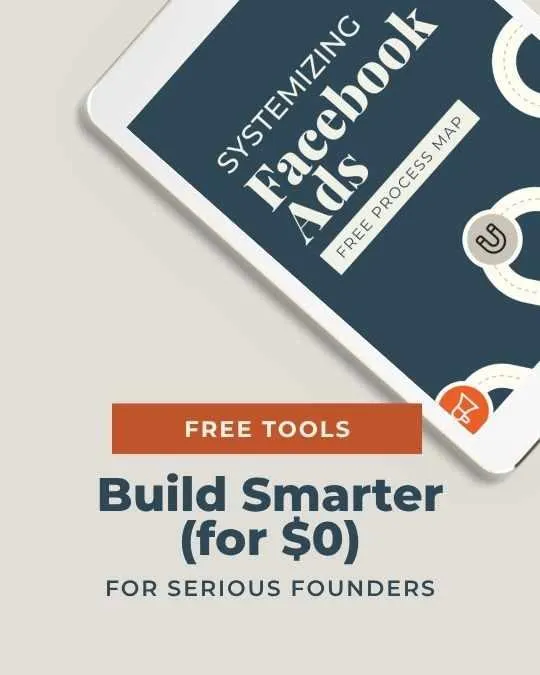The Ultimate Guide to Systemizing Facebook Ads for E-Commerce in 2025
Running Facebook ads for your online store in 2025 isn't about chasing the latest hacks. It's about building a structured system that produces repeatable revenue. Most e-commerce brands jump from one tactic to another, wondering why their ads don't deliver consistent results. A systematic approach to Facebook advertising is what separates thriving online stores from struggling ones in 2025.
Throwing more money at ads won't fix your backend operations. The environment has shifted. While competitors chase new tricks, you need a system that delivers reliable results without requiring you to manually manage campaigns around the clock.
The reality? E-commerce leaders in 2025 don't just make attractive ads. They build systems that produce repeatable sales. You don't need another tactic—you need a documented process that turns Facebook traffic into predictable revenue, freeing you from constant firefighting.
Key Takeaways
Systemizing your Facebook ads creates predictable results instead of relying on random "marketing genius" moments.
Your e-commerce success depends more on operational excellence than flashy ad tactics in 2025.
Building a Facebook ad system that runs without constant supervision is the key to scaling your online store profitably.
What 'Systemizing Facebook Ads' Really Means
Systemizing your Facebook ads means converting scattered tactics into a repeatable process that produces consistent revenue for your e-commerce store. It's about creating order from chaos.
The 5 Parts Of A Facebook Ads System
First, you need clear objectives. What do you want to achieve? Sales, leads, or brand awareness? Select one and align your efforts accordingly.
Second, refine your audience targeting: The right message to the wrong people delivers poor results. Facebook's advanced targeting strategies help you reach those most likely to buy.
Third, produce effective creatives. Your ads should capture attention and clearly communicate value. Use images that stand out and copy that speaks directly to your audience's needs.
Fourth, set up structured testing. Test one variable at a time—like headlines or images—using a documented testing matrix. Avoid changing multiple elements at once to ensure clear results.
Finally, establish a data analysis routine. Review your metrics on a set schedule. Identify what’s working, discontinue what isn’t, and double down on proven winners.
Facebook Ads System Map Diagram
Think of your Facebook advertising system as an integrated workflow:
Traffic Sources → Ad Creative → Landing Page → Offer → Follow-up
Each component supports the others. If one fails, performance suffers across the board.
Leverage AI tools to streamline creative production—use them to generate copy and suggest images that align with your brand guidelines.
Test various placements like feed, stories, and reels, documenting results for each to inform future strategy.
Remember: The goal isn’t just to run ads. It’s to build a system that delivers results consistently, without requiring constant manual oversight.

The Ecom Operator's Playbook: Systemizing Your Facebook Ads in 7 Steps
Running Facebook ads without a system is like operating without a map. Here’s how to build a repeatable process that delivers profitable campaigns with operational clarity.
Step 1: Define Your Campaign Strategy
Start by setting clear objectives. Are you targeting brand awareness, traffic, leads, or purchases? Choose one and document it.
Your primary goal will inform every other decision. For e-commerce, begin with conversion campaigns focused on purchases.
Set measurable targets for ROAS, CPA, and CTR. For example: "Target 2.5x ROAS with a CPA under $30."
Create a campaign strategy tracking document (spreadsheet or Notion template) with these fields:
Campaign objective
Target ROAS
Maximum CPA
Minimum CTR
Weekly ad spend budget
This reference keeps your efforts aligned and minimizes distraction from unproven tactics.
Step 2: Align Facebook Ads With Your Growth Calendar
Synchronize your ad campaigns with your business calendar for intentional execution.
Plan campaigns around:
Product launches
Seasonal peaks (e.g., Black Friday)
Inventory clearance
Cashflow timing
Operational tip: Use a monthly calendar (Google Sheets or Asana) with columns for:
1. Campaign themes
2. Budget allocation
3. Key product focus
4. Testing priorities
This approach eliminates last-minute decisions and ensures every campaign supports broader business objectives.
When marketing and operations are aligned, campaigns drive measurable growth instead of operating in isolation.
Step 3: Build A Creative Production Pipeline
Creative should follow a documented workflow, not improvisation.
Establish a production system with these components:
1. Weekly creative brief session (owner: marketing lead)
2. Production schedule for images, video, and copy (template: Gantt chart or Trello board)
3. Testing matrix for ad formats (e.g., A/B test doc in Google Sheets)
Develop templates for:
Image ads (product, lifestyle, testimonial)
Video ads (demo, UGC, founder message)
Carousel ads (feature highlights, collections)
Collection ads (mobile focus)
Track performance by creative element. Document learnings in a "Creative Performance Log" (sample columns: asset name, format, audience, results, notes).
Build a library of proven assets for rapid iteration and reduced production time.
Step 4: Standardize Campaign Setup & Launch
Prevent errors with a standardized campaign launch SOP. Example checklist (owner: paid media manager):
Set campaign objective
Apply budget limits (daily/lifetime)
Configure targeting (demographics, interests, behaviors)
Upload custom audiences
Create lookalike audiences
Verify Pixel and Conversion API
Add UTM parameters to links
Review ad placement selection
Select bidding strategy (cost cap, lowest cost, etc.)
Use a consistent naming convention: "\[YYYY-MM-DD]\_\[Objective]\_\[Product]\_\[Audience]".
Example: "2025-01-15\_Conversion\_Sneakers\_LAL10".
Store this SOP in your team’s shared knowledge base for easy access and training.
Step 5: Implement A Weekly Reporting & Review Rhythm
Establish a recurring 30-minute review meeting (owner: marketing ops lead) with this agenda:
1. Pull standard reports from Meta Ads Manager
2. Compare performance against documented targets
3. Highlight top and bottom performing campaigns
4. Decide on specific adjustments (pause, scale, iterate)
Use a dashboard (Google Data Studio or Sheets) with:
ROAS by campaign
CPA trends
CTR by creative
Audience breakdown
Device split (mobile vs. desktop)
Document action items and assign owners for each adjustment to ensure follow-through.
Step 6: Close The Loop With Optimization Workflows
Translate data into action with documented "if-then" rules. Example (keep in a living SOP):
If ROAS < 1.5x after 3 days → adjust bid or pause (owner: paid media manager)
If CTR < 1% → test new creative (owner: creative lead)
If CPA > target by 20% → refine audience (owner: media buyer)
If ad frequency > 3 → refresh creative (owner: creative team)
Schedule recurring optimization tasks:
Daily: Budget checks
Twice weekly: Bid strategy review
Weekly: Creative refresh
Bi-weekly: Audience analysis
Keep these workflows documented and accessible for consistent execution, regardless of team changes.
Step 7: Archive Learnings In A Performance Library
Build a searchable "Performance Library" (Notion, Google Drive, or Airtable) with fields for:
Screenshot of ad
Key metrics
Audience targeted
Hypothesis for success/failure
Notes on context (e.g., season, offer type)
Tag entries by product, campaign date, and creative type. Require every campaign owner to log learnings post-campaign.
Review this library before planning new campaigns to avoid repeating mistakes and to scale proven approaches.
Optional Step: Forecast Ad Spend With A Simple Budget Tracker
Maintain a budget tracker (Google Sheets template) with columns for:
Monthly budget caps
Daily spend
ROAS per campaign
Projected vs. actual revenue
Cashflow impact
Set rules for scaling spend: "Increase budget by 20% when ROAS exceeds target for 3 consecutive days."
Assign an owner (e.g., finance lead) for weekly budget review to ensure spend aligns with performance and cashflow.
The Future Of Ads Is Operational
Creative wins the click. Systems drive long-term growth.
If you’re still approving every asset and chasing down your agency, you’re not scaling—you’re manually managing campaigns. It’s time to shift to a systems-first approach.
In 2025, successful e-commerce brands aren’t just running ads. They’re building operational machines that function without constant intervention.
Your competitors are automating processes while you’re still making manual tweaks. This operational gap leads to very different outcomes.
Success is now measured by how well your advertising ecosystem is systemized and how seamlessly it integrates with your business goals.
Key operational takeaways:
Automate 80% of recurring decisions with documented SOPs
Build systems that scale with your business, not just your ad spend
Focus on longitudinal trends, not daily fluctuations
Let data and process drive your strategy, not gut instinct
Facebook Ads in 2025 reward consistency and operational rigor over improvisation.
You don’t need more hacks. You need operational excellence.
Stop chasing the latest targeting strategies. Start building processes that deliver predictable outcomes.
When your ads become operationalized, your business becomes resilient and scalable.
Systemize your ads once, and you’ll stay ahead—no matter how the platform evolves. That’s the real competitive advantage.
Ready to Install a Facebook Ads System That Operates Reliably—Without You?
Here’s a core truth in e-commerce: The most effective Facebook ad systems are built to operate independently of the founder.
Consider this: You started your business to create repeatable revenue, not to manually manage ad campaigns every day.
What changes when you implement a real system:
* Your ads continue running seamlessly, even when you’re away
* You eliminate the daily stress of reactive metric checks
* Your team follows clear processes and knows their responsibilities without constant direction
The key? It’s a repeatable system, not guesswork. It’s about implementing the right tools and documented processes.
“Where do I begin?” is a common question.
Schedule a Strategy Call. We’ll review your current setup, identify operational gaps, and recommend actionable improvements.
Your Facebook ads should be sending messages that convert while you focus on higher-level business priorities.
For a comprehensive solution, our 90-Day Overhaul program transitions your ad operations from ad hoc to systemized. We build the workflows, provide a Creative Brief Template, set up a weekly review rhythm (with assigned owners), and train your team to execute—then hand over complete documentation.
Don’t let your business depend on your daily involvement. When your Facebook ads system is documented and delegated, you unlock sustainable growth.
Ready to reclaim your time and scale with confidence? The system is ready for you.







